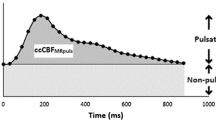Summary
In patients with severe head injuries ICP, MAP and CBF were measured continuously. In most patients there was a positive vasopressor response to increasing ICP, but the ICP/MAP ratio varied considerably in individual cases.
CBF was diminished either by increasing ICP or by decreasing MAP. This effect was more marked with ICP above 40 mm Hg or MAP below 110 mm Hg. In terminal stages there was often a negative MAP/ICP ratio accompanied by massive cerebral hyperaemia.
Similar content being viewed by others
Abbreviations
- ICP:
-
intracranial pressure (mm Hg)
- CBF, Flow:
-
cerebral blood flow (ml/min)
- MAP:
-
mean arterial pressure (mm Hg)
- CPP:
-
cerebral perfusion pressure (mm Hg) (difference between. MAP and ICP)
- BP:
-
blood pressure
References
Arbus, L., Y. Lazorthes, and M. Th. Espagno, Haemodynamic and metabolic pertubations during chronic posttraumatic anamolies of consciousness. Cerebral Blood Flow. Basel: S. Karger. 1972.
Bruce, D. A., Ch. B. Thomas, and T. W. Langfitt et al., Regional cerebral blood flow, intracranial pressure, and brain metabolism in comatose patients. J. Neurosurg.38 (1973), 131–144.
Browder, I. T., and R. Meyers, Observation on behaviour of the systemic blood pressure, pulse, and spinal fluid pressure following cranio cerebral injury. Amer. J. Surg.31 (1936), 405–426.
Dowell, D. G., W. Fitch, V. W. Pickered, and N. J. Coroneous, Haemodynamic effects of experimental intracranial space occupying lesions in passivly ventilated dogs and baboons. Europ. Neurol.8 (1972), 92–96.
Fieschi, C. I., A. Beduschi, and A. Agnoli, Regional cerebral blood flow and intraventricular pressure in acute brain injuries. Cerebral Blood Flow, p. 192–199. Basel: S. Karger. 1972.
Evans, I. P., F. Espey, F. Kristoff, and F. Kimbell, Experimental and clinical observations on rising intracranial pressure. Arch. surg.63 (1951), 107–114.
Gobiet, W., W. J. Bock, J. Liesegang, and W. Grote, Experience with an intracranial pressure transducer, readjustable in vivo. J. Neurosurg.40 (1974), 272.
— —, Der cerebrale Perfusionsdruck. Anaesthesist23 (1974), 253–257.
— —, J. Liesegang, and W. Grote, Intracranial pressure haemodynamics in metabolic disorders in patients with severe head injury. Adv. in Neurosurg. Berlin-Heidelberg-New York: Springer. 1973.
Greenfield, I. C., and G. T. Tindall, Effect of acute increase in intracranial pressure on blood flow in the internal carotid artery of men. J. of Clin. Invest.44 (1965), 1343–1351.
Hamer, I., S. Hoyer, H. Stoeckel, and E. Alberta, Cerebral blood flow and cerebral metabolism in acute increase of intracranial pressure. Acta Neurochir.28 (1973), 95–110.
Hoyer, S., K. Piseol, S. Stoeckel, and I. Hamer, CBF and metabolism in patients with acute brain injury with regard to autoregulation. Cerebral Blood Flow, p. 174–179. Basel: S. Karger. 1972.
Jennet, W. B., I. O. Rowan, A. M. Harper, and I. H. Johnston, Perfusion pressure and cerebral blood flow. Brain and blood flow. Ed. Moss Russel, p. 298–300. London: Pitman. 1971.
Johnston, I. H., I. O. Rowan, A. M. Harper, and W. B. Jennet, Raised intracranial pressure and cerebral blood flow. J. of Neurol., Neurosurg. and Psychiatr.35 (1972), 285–296.
Kety, S. S., H. A. Shenkin, and C. F. Schmidt, The effects of increased intracranial pressure on cerebral circulatory functions in man. J. of clin. Invest.27 (1948), 493–499.
Langfitt, T. W., I. D. Weinstein, and N. F. Kassel, Transmission of increased intracranial pressure. Part I. J. Neurosurg.21 (1964), 989–997.
—, N. F. Kassel, and I. D. Weinstein, Cerebral blood flow with intracranial hypertension. Neurology15 (1965a), 761–773.
Lassen, N. A., and K. Rasmussen, Human cerebral blood flow. Circ. Research19 (1966), 681–688.
Matakas, F., M. Leipert, and J. Franke, Cerebral blood flow during increased subarachnoid pressure. Acta Neurochir.25 (1971), 19–36.
Miller, J. D., A. Stanek, and T. W. Langfitt, Concepts of cerebral perfusion pressure during intracranial hypertension. In: Meyer, J. S., and J. P. Schade: Cerebral Blood Flow, p. 411–432. Amsterdam: Elsevier. 1971.
Marshall, W. J. S., J. C. F. Jackson, and T. W. Langfitt, Brain swelling caused by trauma and arterial hypertension. Arch. Neurol.21 (1969), 545–553.
Overgaard, J., and A. W. Tweed, Cerebral haemodynamics in patients with ICP elevation due to traumatic brain edema. Intracranial Pressure II. Berlin-Heidelberg-New York: Springer. (In press.)
Risberg, J. D., N. Lundberg, and M. D. Ingvar, Regional cerebral blood volume during acute transient rises of intracranial pressure. J. Neurosurg.31 (1969), 301–310.
Seitz, H. D., M. Hirschauer und E. Metzel, Klinische und tierexperimentelle Untersuchungen zum Hirnstoffwechsel und zur Hirndurchblutung beim Schädel-Hirntrauma. Acta Neurochir.6 (1972), 201–209.
Weinstein, J. D., M. D. Thomas, T. W. Langfitt, and N. F. Kassel, Vasopressor response to increased intracranial pressure. Neurology14 (1964), 1118–1131.
Zwetnow, N. N., A. Kjällquist, and B. K. Siesjo, Effects of increased cerebrospinal fluid pressure on the energy metabolism of the brain. Acta Physiol. Scand.339 (1970), 1–31.
Troupp, H., T. Kuurne, M. Kaste, M. Valpalathi, and M. Valtonen, Intraventricular pressure after severe brain injuries: prognostic value and correlation with blood pressure and jugular venous oxygen tension. Intracranial Pressure, p. 222–226. Berlin-Heidelberg-New York: Springer. 1972.
Gobiet, W., W. J. Bock, W. Grote, and W. Bettag, Intracranial pressure and cerebral blood flow in patients with severe head injury. Intracranial Pressure II. Berlin-Heidelberg-New York: Springer. (In press.)
Author information
Authors and Affiliations
Additional information
This work was supported in part by a grant from the „Deutsche Forschungsgemeinschaft“.
Rights and permissions
About this article
Cite this article
Gobiet, W., Grote, W. & Bock, W.J. The relation between intracranial pressure, mean arterial pressure and cerebral blood flow in patients with severe head injury. Acta neurochir 32, 13–24 (1975). https://doi.org/10.1007/BF01405899
Issue Date:
DOI: https://doi.org/10.1007/BF01405899




